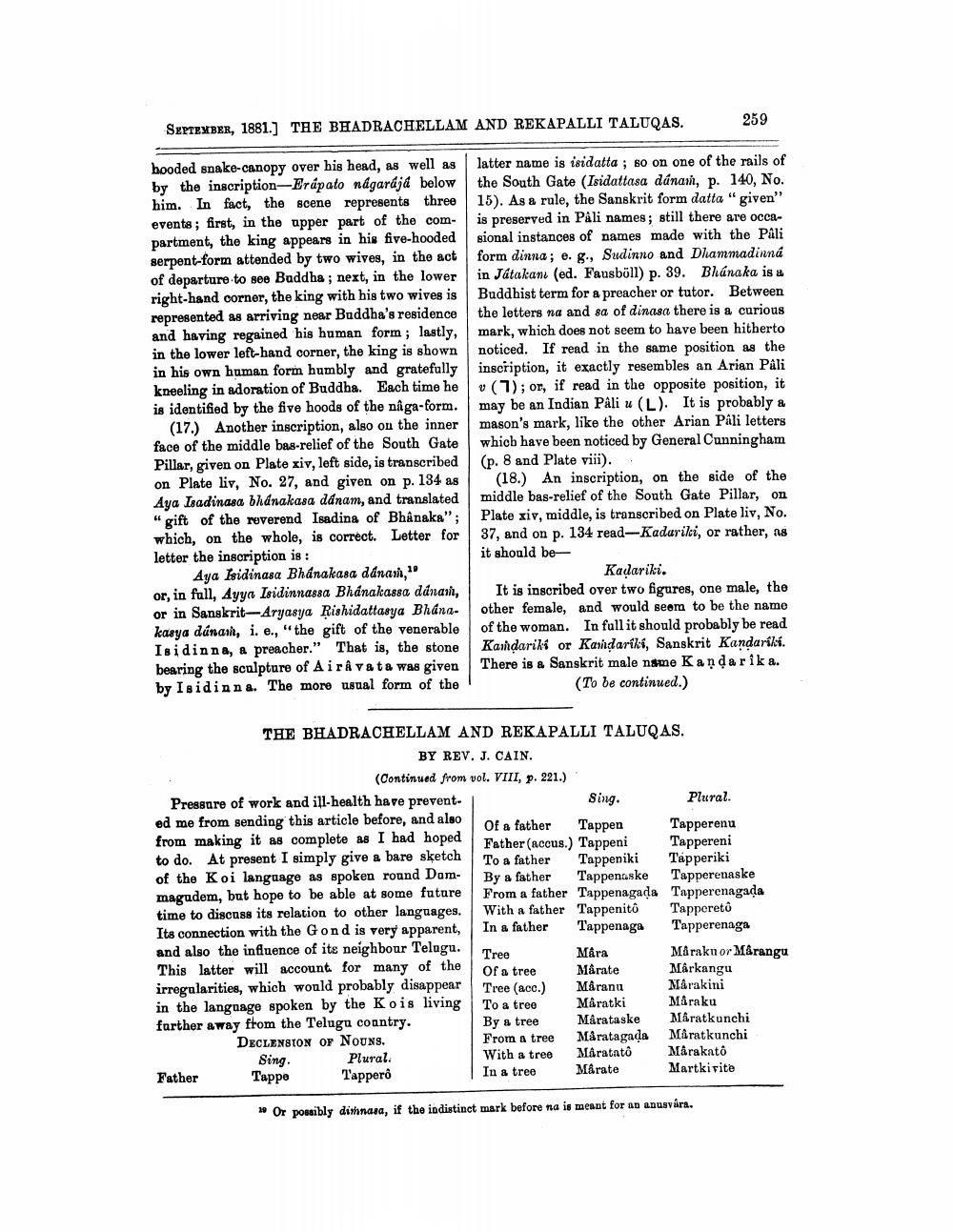________________
SEPTEMBER, 1881.] THE BHADRACHELLAM AND REKAPALLI TALUQAS.
259
booded snake-canopy over his head, as well as latter name is isidatta ; so on one of the rails of by the inscription-Erápato nagarajd below the South Gate (Isidattasa dánan, p. 140, No. him. In fact, the scene represents three 15). As a rule, the Sanskrit form datta "given" events; first, in the upper part of the com- is preserved in Pali names; still there are occapartment, the king appears in his five-hooded sional instances of names made with the Pali serpent-form attended by two wives, in the act form dinna; e. g., Sudinno and Dhammadinná of departure to see Buddha ; next, in the lower in Jatakanı (ed. Fausbüll) p. 39. Bránaka is a right-hand corner, the king with his two wives is Buddhist term for a preacher or tutor. Between represented as arriving near Buddha's residence the letters na and sa of dinasa there is a curious and having regained his human form; lastly, mark, which does not seem to have been hitherto in the lower left-hand corner, the king is shown noticed. If read in the same position as the in his own human form humbly and gratefully inscription, it exactly resembles an Arian Pali kneeling in adoration of Buddha. Each time he v (7); or, if read in the opposite position, it is identified by the five hoods of the någa-form. may be an Indian Pali u (L). It is probably &
(17.) Another inscription, also on the inner mason's mark, like the other Arian Páli letters face of the middle bas-relief of the South Gate which have been noticed by General Cunningham Pillar, given on Plate xiv, left side, is transcribed (p. 8 and Plate viii). on Plate liv, No. 27, and given on p. 134 as (18.) An inscription, on the side of the Aya Isadinasa bhánakasa dánam, and translated middle bas-relief of the South Gate Pillar, on "gift of the reverend Isadina of Bhânaka"; Plate xiv, middle, is transcribed on Plate liv, No. which, on the whole, is correct. Letter for 37, and on p. 134 read-Kadariki, or rather, as letter the inscription is :
it should be Aya Isidinasa Bhánakasa dánan,
Kadariki. or, in full, Ayya Isidinnassa Bhdnakassa ddnan, | It is inscribed over two figures, one male, the or in Sanskrit-Aryasya Rishidattasya Bhana. other female, and would seem to be the name kasya dunaik, i. e., "the gift of the venerable of the woman. In full it should probably be read Isidinna, a preacher." That is, the stone Kandariki or Kandaríki, Sanskrit Kandaríkí. bearing the sculpture of AirAvata was given There is & Sanskrit male name Kandarik a. by Isidinna. The more usual form of the
(To be continued.)
Sing.
THE BHADRACHELLAM AND REKAPALLI TALUQAS.
BY REV. J. CAIN.
(Continued from vol. VIII, p. 221.) Pressure of work and ill-health have prevent
Plural. ed me from sending this article before, and also
Of a father Tappen Tapperenu from making it as complete as I had hoped
Father (accus.) Tappeni Tappereni to do. At present I simply give a bare sketch
To a father Tappeniki Tapperiki of the Koi language as spoken round Dom- By a father Tappenaske Tapperenaske magudem, but hope to be able at some future From a father Tappenagada Tapperenagada time to discuss its relation to other languages. With a father Tappenito Tappereto Its connection with the Gond is very apparent, In a father Tappenaga Tapperenaga and also the influence of its neighbour Telugu.
Tree Mára
Maraku or Márangu This latter will account for many of the
Of a tree Marate Markangu irregularities, which would probably disappear Tree (acc.) Maranu
Marakini in the language spoken by the Kois living
To a tree Máratki
Maraku farther away from the Telugu country.
By a tree Mårataske Máratkunchi DECLENSION OF Nouns.
From a tree Maratagada Maratkunchi Sing. Plural.
With a tree Maratato Mârakato Father Tappe Tappero
In a tree Marate Martkivite
* Or possibly dishnasa, if the indistinct mark before na is meant for an anusara.




